A Bell Named Marie
 03.24.2013
03.24.2013
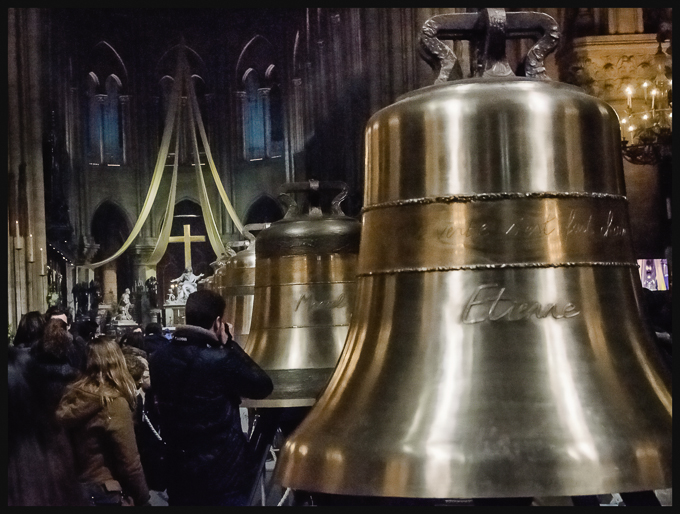
Richard was out shooting peacocks in the Bois de Boulogne, while I was home doing some spring cleaning. We are to meet in front of Shakespeare and Company to witness the first ringing of the nine new bells at Notre Dame, to celebrate the eight-hundred-and-fiftieth anniversary of the cathedral.
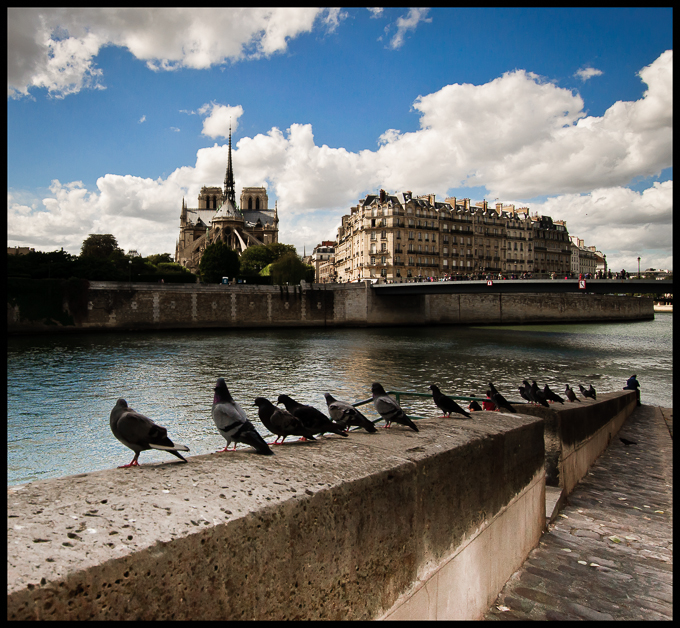
As I turn from rue Lagrange towards the Seine, I can see thousands of people here for the event.
There he is! We embrace, then weave between cars and motorcycles across the Quai de Montebello. Richard finds a spot against a wall from which to record the sounds. I want to see if I can get closer, though the crowd is daunting.
I cross the Pont au Double and follow two teenage boys who part the crowd like Moses. We make our way to a low fence which holds us back from a big swath of grass. You must not walk on the grass in Paris. Pelouse au repos hivernal du 15/10 au 15/04. The grass is having its winter rest from October 10 to April 15.
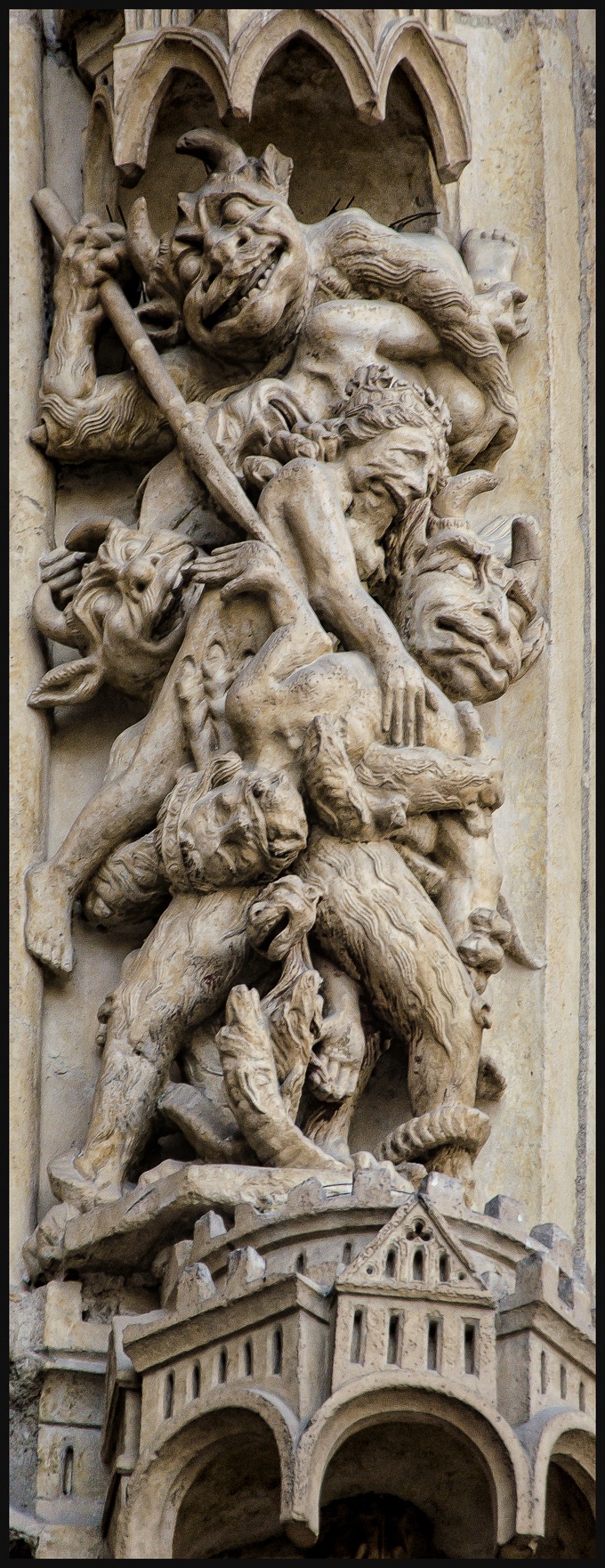
A Spaniard is holding a black-eyed, black-haired child, a girl, to my left. How do I know they’re Spanish? Because the child is chattering in Spanish with a Castilian accent.
The bells begin tentatively. The first sounds are almost delicate. Bright and clear, bringing tears.
I look around me at the crowd and what this means to Catholics around the world. During the French Revolution, all the bells except one were melted down for cannons and coins. Only Emanuel, the biggest, a 13-ton bourdon bell, remained. Four other bells were added in the 1850s, but they were so discordant that Parisians joked they’d made Quasimodo deaf. But for years they rang every 15 minutes in Paris, ding dang.

I can see both the front of the cathedral and a huge screen on which Archbishop Andre Armand Vingt-Trois is speaking in slow, clear French. It is a pleasure when the rhythm of speech is slow enough for me to capture it all. That is, if the Spanish child, mouth smeared in chocolate, weren’t asking loud questions right next to my left ear. I glance at her, at her father. It’s written on his face: My child is the exception to all rules. From every courtesy such as silence in churches, films, libraries, my child is exempt.
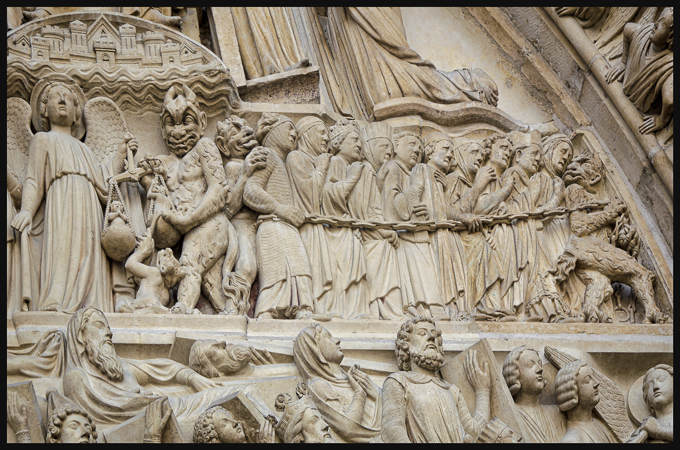
A family of teenagers with a gray-haired woman elbows through the crowd. Everyone glares. The teenagers muscle their way to the low fence, easily vault it and onto the grass. The woman chooses not to follow. She chooses instead to squeeze in next to me between the Spanish child and my ribs. She has no sense of bodily space (which most French people decidedly do) and keeps bumping against me and the couple in front of her.
At last the bells all ring. I watch the close-up images on the screen. They remind me of something. Yes, the great iron skirt of a woman swinging, her legs rigid, her ankles and feet tied together—no, fused. An eternal virgin. The Virgin Mary. Is this bell the biggest of the new ones, Marie? She is the only new bell which will ring in the Gothic south tower, joining Emmanuel. The other bells—Jean-Marie, Maurice, Benoît-Joseph, Etienne, Marcel, Denis, Anne-Geneviève and Gabriel—will sound out in the north tower, high above the Seine.

My mind floods with images from the film I saw the night before: Vision: From the Life of Hildegard von Bingen. A German film directed by Margarethe von Trotta in 2009, it stars Barbara Sukowa as the 12th century Christian mystic, Benedictine nun, composer, philosopher, playwright, naturalist, scientist and ecological activist, Hildegard of Bingen. It is a great film, a film of beauty and suffering and gravitas. It is gripping for its dramatization of an historical character of visionary brilliance.
And it illuminates the mythical. Hildegard lived during the middle point of the Piscean era, at the beginning of the twelfth century, half way between the birth of Christ and present time, from 1198 to September 17, 1179.
Pisces, the last sign, of dreams, suffering, compassion, final reckoning. Christ, the fish, Poseidon and Pisces. And its opposite polarity, the Virgin Mary, the spiritual body, Demeter and Virgo. The suffering of the monks and nuns, the celibate marriage to the divine—it is all here in its agony and splendor. At that time in Catholic history, the price for a nun getting pregnant by a monk was banishment or often, suicide. And the price for the monk? Nothing.
And so this metaphor of a bell named Mary, Marie, the holy Virgin.
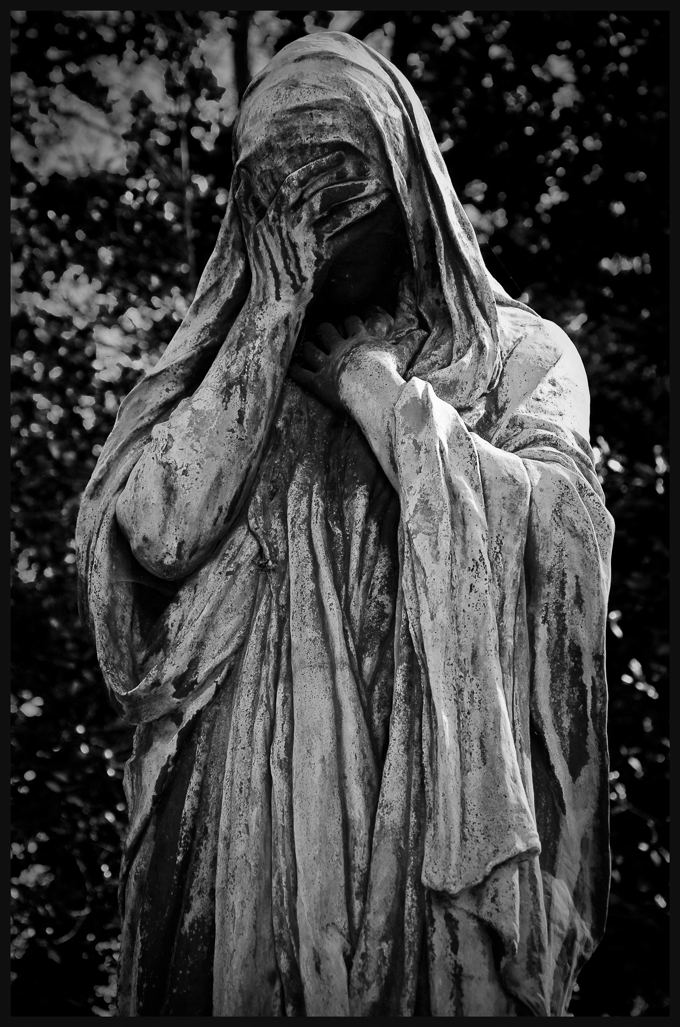
Some around me jostle and eat chocolate. Others film the ceremony on the screen. Others watch, faces uplifted, tears streaming their cheeks. People have come from all around the world to be here for this moment, the first time in over two centuries that the cathedral has had a full complement of bells.
The music ends. One of the artisans of Cornille-Havard (France’s most renowned bell foundry) who made these bells lovingly describes his craft. This is the quality we love most about the French: their exquisite attention to the details of artistic craft.
I make my way through the scattering crowd back across the Pont au Double to meet Richard at his spot along the Seine. There he is! Unfortunately, his video captured mostly the sounds of traffic and talking humans, rather than the new bells. But we were there.
(And here's a link to TV channel BFM, which had better audio than we did.)
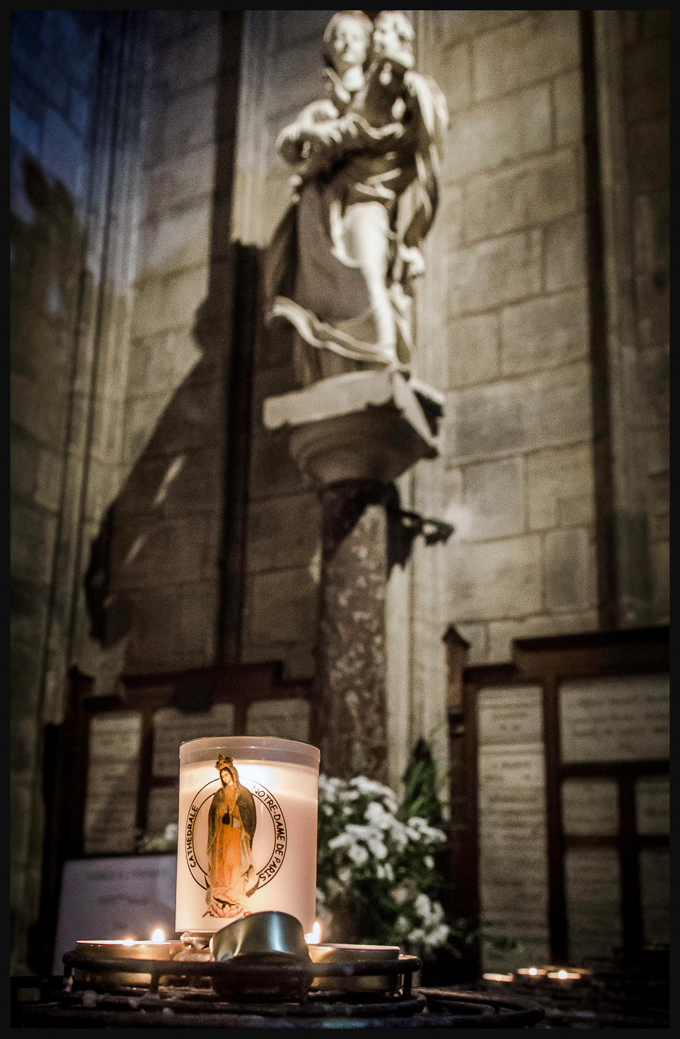


Reader Comments (9)
They *fixed* Notre Dame!! Those crazy Frenchies, always doing the right thing. I climbed to the top once and marveled at the construction, the stairways, the bell towers and the attention to craft. These people had serious time on their hands and either unlimited budget or extremely cheap labor.. all those stones were hand cut and placed.
David
"The grass is having its winter rest from October 10 to April 15." I love it. I didn't know grass hibernated.
David!
Great to hear from you. Come back to Paris and we'll race you to the top of Notre Dame.
Well, I don't know about having that much time on their hands, since the building took from 1163 to 1345 to complete, almost two centuries. But Jean de Jandum would agree with you on the marvel of the construction. In his 1323 "Treatise on the Praises of Paris," he called it one of Paris's three most important buildings, and raved:
"That most terrible church of the most glorious Virgin Mary, mother of God, deservedly shines out, like the sun among stars. And although some speakers, by their own free judgment, because [they are] able to see only a few things easily, may say that some other is more beautiful, I believe however, respectfully, that, if they attend more diligently to the whole and the parts, they will quickly retract this opinion. Where indeed, I ask, would they find two towers of such magnificence and perfection, so high, so large, so strong, clothed round about with such a multiple variety of ornaments? Where, I ask, would they find such a multipartite arrangement of so many lateral vaults, above and below? Where, I ask, would they find such light-filled amenities as the many surrounding chapels? Furthermore, let them tell me in what church I may see such a large cross, of which one arm separates the choir from the nave. Finally, I would willingly learn where [there are] two such circles, situated opposite each other in a straight line, which on account of their appearance are given the name of the fourth vowel [O] ; among which smaller orbs and circlets, with wondrous artifice, so that some arranged circularly, others angularly, surround windows ruddy with precious colors and beautiful with the most subtle figures of the pictures. In fact I believe that this church offers the carefully discerning such cause for admiration that its inspection can scarcely sate the soul."
Ya know? Thanks for reminding us that each stone was hand cut and placed!
Marley said to give you a big meow.
Much love,
Kaaren and Richard
Julie,
Wonderful to hear from you. That is JUST what we thought. It is so like the French, so endearing to treat growing things with such tender respect. It's part of the great connection to nature and food and cuisine in this land. We love the French!
And we love our sister.
XOXO,
Kaaren and Richard
FIVE SHORT MEDITATIONS ON THE VIRGIN MARY
for Abdal-Hakim Murad
1
The Virgin Mary sat on a rock that was not wholly rock
in a world that was not wholly world
in a light that was Light direct
in the echo of a Command that came from God direct
whose womb was now to house a halo more than she could
possibly long for
and which made her fear
and caused her angel messenger to comfort her
as he stood at the door and mentioned how
God had designated her the hallowed hall for His pure breath to enter
to make a child with no seed but Himself
to show mankind His holy fatherhood over all
within the physical
but without physical union
2
The pen is hardly lifted
The penalty for birth is death
But he who would be born without coitus
would slide out of death without its mortal coil
Would be taken up to God without entering death’s womb
as he had entered Mary’s womb without birth’s usual folderol
She clutched a tree to steady herself
and dates fell to the ground around her
And he spoke to her from herself
to steady her
Rings of tumult sang around her
The Garden’s tree was now there to strengthen her
her nearing it part of God’s ordained structure
to redeem Adam and Eve’s descent to earth
by new prophecy through standing under
the virgin birth-tree’s sacred agency
Adam of no visible parents
Eve of no mother but father Adam’s rib-side
being both mother and father
now terrestrialized again in Mary’s husbandless pregnancy
though all of us are actually children
of much more than our mere mother’s earthly sympathy
3
I saw Mary board a bus at Broad and State
her head covered and her face radiant
small and held within herself
careful and preoccupied
a heaven seeming to be wrapped around her
her cheeks red her lips dry her eyes lowered
interior moisture her preferred cloister
the bus passengers sudden ghosts before her
her shoes small and tattered
her hands carrying a book
If any had spoken to her she might have become lost
If she had spoken to anyone
they might have become saved
4
None can be Mother of God but God
nor Father of flesh but God Himself
Jesus begat in light sat in light and was transformed into light
beyond light’s shapes of dark and light
his salutation from where he is continues to excite us
just as Mary’s humility brings us home
to where impossible things are true
and true things impossible or possible by our own lights
to submit as purely to God’s sheer command of: Be!
more than enough to be
in Being’s age-long mystery
5
In Ephasis is Artemis
with multitudes of breasts
and legend says where Mary went
and where she died and rests
Teets our forms are fed from
virgin light that salves our souls
the two eternal females
through whom our life unrolls
The Virgin ever virginal
in modesty extreme
and Artemis whose many breasts
supply an endless stream
One statue standing among rocks
the other in her cave
whose house of stone is all alone
within the Light we crave
____________________________
NOTE
Walking in the woods as is my wont in the morning
June 9th 2005 Philadelphia Pennsylvania after strong storms and
all the trees dry now creaking in the heat and humidity
thinking of this poem
thinking of Mary peace be upon her
walking along the trail wondering to myself about the
Sufi Tariqa of the Mariamiyya
I suddenly hear a crack like horrendous thunder seemingly from
far away but look up above me in time to see a
huge bough break from the top of a tall tree with a giant screech and
hurtle down toward me at seemingly supersonic speed
I step aside yelling “Allah!” automatically heart thumping
and the heavy branch crash-lands exactly where I
stood a split second before and breaks into four or five
raw pieces cracked and shattered and me shocked and grateful
thanking Allah over and over thanking Him with all my being
my position just under it one split second before happily not there for it to
crash onto me now safe and sound at the side of the trail
I wonder at the force of it as I continue now to wonder
Allah’s full and Awful Power exposed to me direct from the
core of the universe as if sky and earth and mortality itself were
opened up in the blink of an eye
and my life actually only a literal hair’s breadth away
from death
At the Thursday night Sufi meeting I describe it in detail
to Baji our Pakistani shaykha and first thing she asks is
“What were you thinking just before the bough broke and fell?”
and when I tell her I was thinking of the Virgin Mary
she says without a moment’s pause
“Just as Allah protected and saved Mariam
so Mariam protected you
and saved you!”
6/7-6/9/2005
Dear Daniel,
You are so close to the Virgin Mary in poetic contemplation. I especially loved stanza 3, and thought about it later, and talked about it with Richard as we walked to the Pompidou for the last night of the Salvador Dali show, how you capture her humility and radiance:
"I saw Mary board a bus at Broad and State
her head covered and her face radiant...
a heaven seeming to be wrapped around her...
If any had spoken to her she might have become lost
If she had spoken to anyone
they might have become saved"
And that story of walking in the woods! Amazing!
Much love,
Kaaren (& Richard)
I too loved Daniel's poem. The first line slew me. Anyone who is capable of helping me relate to Mary has my vote.
And Kaaren, the details of humanity you describe! The Spanish child, 'exception to all rules'! I've never mastered the art of being amused while being annoyed. You brought that whole expectant crowd to life for me. And Richard. What can I say? You've found your love, your muse, your passion in those streets. Whereas NY is the type of city that, if you relate to it, fits you like a coat (you make it yours — Rome is like that for me too), Paris always seemed the beloved unattainable that you have to woo and woo, day in and day out.
And you're wooing her well.
Anna, thank you.
I was probably prepared for Paris by growing up (fifth generation) in San Francisco, which many folks say is the "most European," and "best looking" city in the US.
I doubt the first statement, since Europe reveres and honors age, and California doesn't, but I do believe the second.
Just before I left SF for L.A., in 1987, I met a Jungian analyst named John Beebe, who was also a film buff, primarily Hitchcock. I did a weekend workshop in which he analyzed Vertigo, and classified San Francisco as an "anima city," dazzling in its constant beauty, and compared Scotty's (James Stewart's) overwhelming attraction for Madeleine (Kim Novak) with his equal obsession with prowling San Francisco. He was anima-obsessed, with the city and with Madeleine.
I think Paris is equally an "anima city," with a vertiginous beauty, and I prowl her constantly, finding that beauty in everything. I try to capture this in the photographs. Even the crowds of demons in the reliefs on the face of Notre Dame (and the crowd of demons Kaaren found herself in) are beautiful.
Thank you for your always-perceptive insights into our collaboration here. They make us think deeply every time about what the heck we're doing.
Many hugs,
Richard (and Kaaren)
I love the idea of Paris as an anima city. And yes, the exquisite attention the French pay to craft is a crucial part of the mystery of this draw.